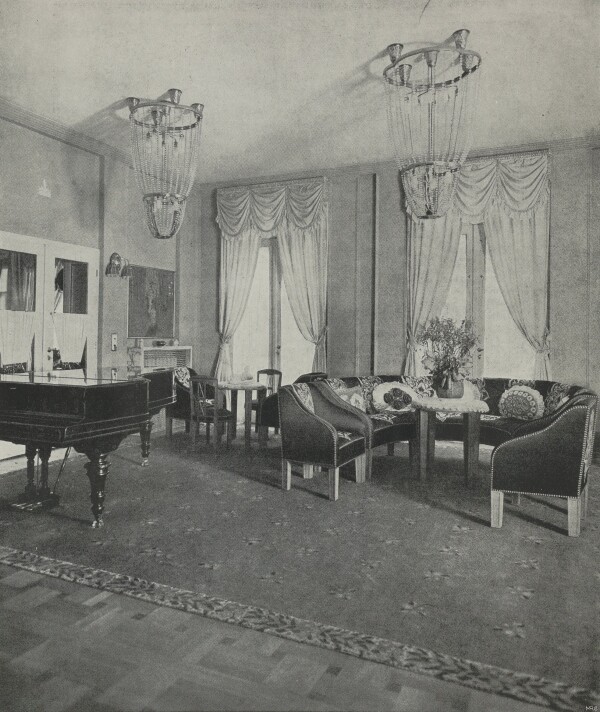The Gallias
Gustav Klimt: Portrait of Hermine Gallia, 1903/04, The National Gallery
©

Insight into the apartment of Hermine and Moriz Gallia, circa 1915
© Klimt Foundation, Vienna
Moriz and Hermine Gallia were important patrons of the Vienna Secession and the Wiener Werkstätte around 1900. Most of their private collection – including furniture by Josef Hoffmann and two paintings by Klimt – was successfully moved abroad during the National Socialist regime and thus saved, unlike many other art collections.
The wealthy couple Moriz and Hermine Gallia were originally from Moravia and Silesia (now Czech Republic). The family climbed the social ladder in Vienna, where Moriz Gallia for instance worked for the chemist and entrepreneur Carl Auer von Welsbach. Around 1900, the couple began to act as patrons of the arts. They primarily supported and collected the Secessionists, including Gustav Klimt, Ferdinand Andri and Carl Moll, and later the artists of the Wiener Werkstätte.
Wohllebengasse
At first, the family lived on Schleifmühlgasse in the 4th District of Vienna for several years. In the mid-1910s, the couple and their four children, who had been born between 1895 and 1899, moved to a residential building they had commissioned at Wohllebengasse 4, only a few streets away. They had officially purchased the property in 1912. Their new apartment spanned over 700 square meters and several of its rooms were decorated by the architect Josef Hoffmann and the Wiener Werkstätte. Several photographs, which were for instance published in the magazine Deutsche Kunst und Dekoration in 1915/16, testify to the ingenuity with which the two paintings by Klimt that the Gallias had purchased were prominently staged by Hoffmann in these rooms: Beech Forest II (Beech) (1903, current location unknown) in the grand parlor, near the piano, and the large-scale Portrait of Hermine Gallia (1903/04, National Gallery, London) in the ladies’ parlor. The latter work was presented for the first time – in an unfinished state – at the “XVIII. Ausstellung der Vereinigung bildender Künstler Österreichs Secession” [“18th Exhibition of the Association of Austrian Artists Vienna Secession”], Klimt’s solo exhibition.
Emigration of the Gallia Children
Moriz Gallia died in the summer of 1918. His wife and principal heir temporarily took over his business activities in September 1918, according to a report in the Wiener Zeitung. When she died in 1936, the couple’s art collection went to their three surviving children, who emigrated to Australia during the National Socialist regime. They were able to export and thus save many objects from their parents’ art collection, which also included works by artists such as Michael Powolny and Emil Orlik; they also saved Klimt’s painting of their mother. The family sold the latter work via Christie’s in 1971. The portrait is now part of the collection of the National Gallery in London.
Literature and sources
- Marion Krammer, Niko Wahl: Klimt Lost, Vienna 2018, S. 124-141.
- Tim Bonyhady: Wohllebengasse. Die Geschichte meiner Wiener Familie, Vienna 2013.
- Georg Gaugusch: Wer einmal war. Das jüdische Großbürgertum Wiens 1800–1938, Band 1, Vienna 2011, S. 835-837.
- Rohrpost-Kartenbrief von Gustav Klimt in Wien an Moriz Gallia in Wien (06.12.1910). EXHI013119.
- Brief mit Kuvert von Gustav Klimt in Wien an Emilie Flöge (undatiert). Autogr. 959/55-1, .
- Felix Czeike (Hg.): Historisches Lexikon Wien, Band 5, Vienna 1997, S. 671.
- Adolph Lehmann's allgemeiner Wohnungs-Anzeiger. Nebst Handels- u. Gewerbe-Adressbuch für d. k. k. Reichshaupt- u. Residenzstadt Wien u. Umgebung, 57. Jg., Band 2 (1915), S. 340.
- Adolph Lehmann's allgemeiner Wohnungs-Anzeiger. Nebst Handels- u. Gewerbe-Adressbuch für d. k. k. Reichshaupt- u. Residenzstadt Wien u. Umgebung, 56. Jg., Band 2 (1914), S. 341.
- Tobias G. Natter (Hg.): Gustav Klimt. Sämtliche Gemälde, Vienna 2012, S. 531-532.
- Tobias G. Natter, Gerbert Frodl (Hg.): Klimt und die Frauen, Ausst.-Kat., Upper Belvedere (Vienna), 20.09.2000–07.01.2001, Cologne 2000, S. 104-107.
- Wiener Zeitung, 27.09.1918, S. 644.
- Deutsche Kunst und Dekoration, Band 37 (1915/16), S. 400, S. 407.
- Wiener Zeitung, 21.08.1918, S. 2.
- Neue Freie Presse, 07.02.1936, S. 16.
- Neues Wiener Tagblatt, 12.03.1912, S. 6.

